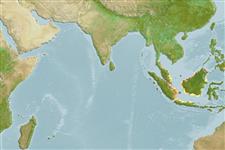>
Atheriniformes (Silversides) >
Phallostethidae (Priapiumfishes)
Etymology: Phallostethus: Greek, phallos = penis + Greek, stetho, stethion = brest; literal = to prick a little breast (Ref. 45335).
Eponymy: Dr Charles Leh Moi Ung is Curator of Zoology, Sarawak Museum Department and works with the Ministry of Environment and Tourism. [...] (Ref. 128868), visit book page.
Environment: milieu / climate zone / rango de profundidad / distribution range
Ecología
marino; salobre pelagic-neritic. Tropical
Western Pacific: Borneo.
Tamaño / Peso / Age
Madurez: Lm ? range ? - ? cm
Max length : 2.7 cm SL macho / no sexado; (Ref. 12769); 2.8 cm SL (female)
Short description
Claves de identificación | Morfología | Morfometría
Differs from all congeners by having the following characters: second ctenactinium with eight serrae in adult males; 28 caudal vertebrae with no sexual dimorphism in the number of precaudal vertebrae; 28 or more teeth on paradentary; all males are sinistral (Ref. 90869).
Body shape (shape guide): elongated.
Fertilization is internal and eggs are attached to the substrate via adhesive filaments (Ref. 43413).
Life cycle and mating behavior
Madurez | Reproducción | Puesta | Huevos | Fecundidad | Larva
Pelvic fins in males are modified to form part of a complex thoracic clasping organ (Ref. 205).
Parenti, L.R., 1996. Phylogenetic systematics and biogeography of phallostethid fishes (Atherinomorpha, Phallostethidae) of northwestern Borneo, with description of a new species. Copeia 1996(3):703-712. (Ref. 12769)
IUCN Red List Status (Ref. 130435: Version 2025-1)
Threat to humans
Harmless
Human uses
Herramientas
Special reports
Download XML
Fuentes de Internet
Estimates based on models
Preferred temperature (Referencia
123201): 28.2 - 29.1, mean 28.7 °C (based on 198 cells).
Phylogenetic diversity index (Referencia
82804): PD
50 = 0.6250 [Uniqueness, from 0.5 = low to 2.0 = high].
Bayesian length-weight: a=0.00389 (0.00180 - 0.00842), b=3.12 (2.94 - 3.30), in cm total length, based on all LWR estimates for this body shape (Ref.
93245).
Nivel trófico (Referencia
69278): 3.1 ±0.3 se; based on size and trophs of closest relatives
Fishing Vulnerability (Ref.
59153): Low vulnerability (10 of 100).
🛈
